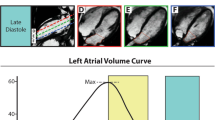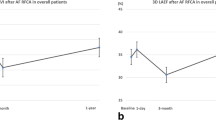Abstract
Recently, left atrial (LA) vortex flow analysis using contrast transesophageal echocardiography (TEE) has been shown to be feasible and has demonstrated significant differences in vortex flow morphology and pulsatility between normal subjects and patients with atrial fibrillation (AF). However, the relationship between LA vortex flow and electrophysiological properties and the clinical significance of LA vortex flow are unknown. The aims of this study were (1) to compare LA vortex flow parameters with LA voltage and (2) to assess the predictive value of LA vortex flow parameters for the recurrence of AF after radiofrequency catheter ablation (RFCA). Thirty-nine patients with symptomatic non-valvular AF underwent contrast TEE before undergoing RFCA for AF. Quantitative LA vortex flow parameters were analyzed by Omega flow (Siemens Medical Solution, Mountain View, CA, USA). The morphology and pulsatility of LA vortex flow were compared with electrophysiologic parameters that were measured invasively. Hemodynamic, electrophysiological, and vortex flow parameters were compared between patients with and without early recurrence of AF after RFCA. Morphologic parameters, including LA vortex depth, length, width, and sphericity index were not associated with LA voltage or hemodynamic parameters. The relative strength (RS), which represents the pulsatility power of LA, was positively correlated with LA voltage (R = 0.53, p = 0.01) and LA appendage flow velocity (R = 0.73, p < 0.001) and negatively correlated with LA volume index (R = −0.56, p < 0.001). Patients with recurrent AF after RFCA showed significantly lower RS (1.7 ± 0.2 vs 1.9 ± 0.4, p = 0.048) and LA voltage (0.9 ± 0.7 vs 1.7 ± 0.8, p = 0.004) than patients without AF recurrence. In the relatively small LA dimension group (LA volume index ≤ 33 ml/m2), RS was significantly lower (2.1 ± 0.3 vs 1.7 ± 0.1, p = 0.029) in patients with the recurrent AF. Quantitative LA vortex flow analysis, especially RS, correlated well with LA voltage. Decreased pulsatility strength in the LA was associated with recurrent AF. LA vortex may have incremental value in predicting the recurrence of AF.



Similar content being viewed by others
References
Balk EM, Garlitski AC, Alsheikh-Ali AA, Terasawa T, Chung M, Ip S (2010) Predictors of atrial fibrillation recurrence after radiofrequency catheter ablation: a systematic review. J Cardiovasc Electrophysiol 21(11):1208–1216
Hong G-R, Kim M, Pedrizzetti G, Vannan MA (2013) Current clinical application of intracardiac flow analysis using echocardiography. J Cardiovasc Ultrasound 21(4):155
Cimino S, Pedrizzetti G, Tonti G et al (2012) In vivo analysis of intraventricular fluid dynamics in healthy hearts. Eur J Mech B Fluids 35:40–46
Sengupta PP, Pedrizzetti G, Kilner PJ et al (2012) Emerging trends in CV flow visualization. JACC Cardiovasc Imaging 5(3):305–316
Gao H, Claus P, Amzulescu MS, Stankovic I, D’Hooge J, Voigt JU (2012) How to optimize intracardiac blood flow tracking by echocardiographic particle image velocimetry? Exploring the influence of data acquisition using computer-generated data sets. Eur Heart J Cardiovasc Imaging 13(6):490–499
Hong GR, Pedrizzetti G, Tonti G et al (2008) Characterization and quantification of vortex flow in the human left ventricle by contrast echocardiography using vector particle image velocimetry. JACC Cardiovasc Imaging 1(6):705–717
Park KH, Son JW, Park WJ et al (2013) Characterization of the left atrial vortex flow by two-dimensional transesophageal contrast echocardiography using particle image velocimetry. Ultrasound Med Biol 39(1):62–71
Camm AJ, Kirchhof P, Lip GY et al (2010) Guidelines for the management of atrial fibrillation: the Task Force for the Management of Atrial Fibrillation of the European Society of Cardiology (ESC). Eur Heart J 31(19):2369–2429
Jiamsripong P, Honda T, Reuss C et al (2007) Three methods for evaluation of left atrial volume. Eur J Echocardiogr. doi:10.1016/j.euje.2007.05.004
Adrian RJ (1991) Particle-imaging techniques for experimental fluid mechanics. Annu Rev Fluid Mech 23(1):261–304
Pak HN, Oh YS, Lim HE, Kim YH, Hwang C (2011) Comparison of voltage map-guided left atrial anterior wall ablation versus left lateral mitral isthmus ablation in patients with persistent atrial fibrillation. Heart Rhythm 8(2):199–206
Lin YJ, Tai CT, Kao T et al (2008) Consistency of complex fractionated atrial electrograms during atrial fibrillation. Heart Rhythm 5(3):406–412
Park JH, Pak HN, Choi EJ et al (2009) The relationship between endocardial voltage and regional volume in electroanatomical remodeled left atria in patients with atrial fibrillation: comparison of three-dimensional computed tomographic images and voltage mapping. J Cardiovasc Electrophysiol 20(12):1349–1356
Park J, Joung B, Uhm JS et al (2014) High left atrial pressures are associated with advanced electroanatomical remodeling of left atrium and independent predictors for clinical recurrence of atrial fibrillation after catheter ablation. Heart Rhythm. doi:10.1016/j.hrthm.2014.03.009
Fyrenius A, Wigstrom L, Ebbers T, Karlsson M, Engvall J, Bolger AF (2001) Three dimensional flow in the human left atrium. Heart 86(4):448–455
Vaziri SM, Larson MG, Benjamin EJ, Levy D (1994) Echocardiographic predictors of nonrheumatic atrial fibrillation. The Framingham heart study. Circulation 89(2):724–730
Marcus GM, Yang Y, Varosy PD et al (2007) Regional left atrial voltage in patients with atrial fibrillation. Heart Rhythm 4(2):138–144
Fiala M, Wichterle D, Chovancik J et al (2010) Left atrial voltage during atrial fibrillation in paroxysmal and persistent atrial fibrillation patients. Pacing Clin Electrophysiol 33(5):541–548
Son JW, Park WJ, Choi JH et al (2012) Abnormal left ventricular vortex flow patterns in association with left ventricular apical thrombus formation in patients with anterior myocardial infarction: a quantitative analysis by contrast echocardiography. Circ J 76(11):2640–2646
Abe H, Caracciolo G, Kheradvar A et al (2013) Contrast echocardiography for assessing left ventricular vortex strength in heart failure: a prospective cohort study. Eur Heart J Cardiovasc Imaging. doi:10.1093/ehjci/jet049
Goliasch G, Goscinska-Bis K, Caracciolo G et al (2013) CRT improves LV filling dynamics: insights from echocardiographic particle imaging velocimetry. JACC Cardiovasc Imaging 6(6):704–713
Acknowledgments
We appreciate Mr. Jun-Kee Lee for his technical assistance. Geu-Ru Hong—Research supported by Siemens Medical Solution.
Conflict of interest
None.
Author information
Authors and Affiliations
Corresponding author
Electronic supplementary material
Below is the link to the electronic supplementary material.
Supplementary material 2 (WMV 13090 kb)
Supplementary material 3 (WMV 13051 kb)
Rights and permissions
About this article
Cite this article
Lee, J.M., Hong, GR., Pak, HN. et al. Clinical impact of quantitative left atrial vortex flow analysis in patients with atrial fibrillation: a comparison with invasive left atrial voltage mapping. Int J Cardiovasc Imaging 31, 1139–1148 (2015). https://doi.org/10.1007/s10554-015-0671-5
Received:
Accepted:
Published:
Issue Date:
DOI: https://doi.org/10.1007/s10554-015-0671-5




